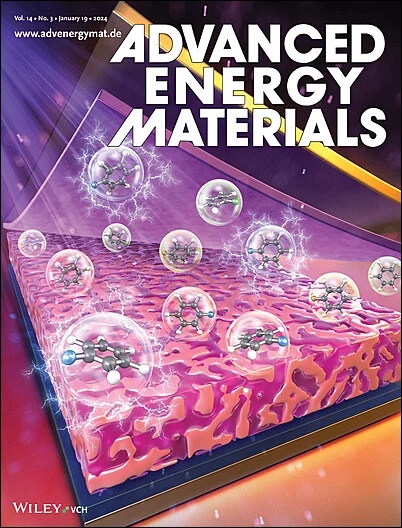Enhanced Bifunctional Oxygen Electrocatalysis by Synergistic Active Heterostructure Design
IF 26
1区 材料科学
Q1 CHEMISTRY, PHYSICAL
引用次数: 0
Abstract
Due to the slower kinetics and different reaction requirements of the oxygen reduction reaction (ORR) and oxygen evolution reaction (OER), it is challenging to balance between the two reaction properties. In this work, CoFe增效活性异质结构设计增强双功能氧电催化
由于氧还原反应(ORR)和析氧反应(OER)的反应动力学较慢,反应要求不同,因此很难在两种反应性质之间取得平衡。在这项工作中,CoFe2O4/Co异质结构是通过在多孔碳球衬底(CSs)上原位加载碳点(CDs)介导的金属位点来设计的,以获得高度耐用的双功能催化剂(FeCoCDs/CSs)。实验和理论计算表明,强金属载流子相互作用界面促进了CoFe2O4和Co之间的动态电子传递,提高了电子导电性,增强了FeCoCDs/CSs催化剂的稳定性。CDs有效调节Co活性位点的电子环境,优化O*/OH*的吸附行为,促进最终产物的释放。所设计的fecocd /CSs具有优异的ORR/OER性能,氧电位差(ΔE)为0.635 V。含有FeCoCDs/CSs的液态锌-空气电池(ZABs)具有出色的循环稳定性(ΔE),为0.635 V)和高往返效率(64.7%)。具有fecocd /CS的柔性ZABs (FZABs)在宽温度范围(60 -‐40°C)内也具有出色的循环稳定性,证明了其坚固性和在各种环境条件下的实际应用适用性。
本文章由计算机程序翻译,如有差异,请以英文原文为准。
求助全文
约1分钟内获得全文
求助全文
来源期刊

Advanced Energy Materials
CHEMISTRY, PHYSICAL-ENERGY & FUELS
CiteScore
41.90
自引率
4.00%
发文量
889
审稿时长
1.4 months
期刊介绍:
Established in 2011, Advanced Energy Materials is an international, interdisciplinary, English-language journal that focuses on materials used in energy harvesting, conversion, and storage. It is regarded as a top-quality journal alongside Advanced Materials, Advanced Functional Materials, and Small.
With a 2022 Impact Factor of 27.8, Advanced Energy Materials is considered a prime source for the best energy-related research. The journal covers a wide range of topics in energy-related research, including organic and inorganic photovoltaics, batteries and supercapacitors, fuel cells, hydrogen generation and storage, thermoelectrics, water splitting and photocatalysis, solar fuels and thermosolar power, magnetocalorics, and piezoelectronics.
The readership of Advanced Energy Materials includes materials scientists, chemists, physicists, and engineers in both academia and industry. The journal is indexed in various databases and collections, such as Advanced Technologies & Aerospace Database, FIZ Karlsruhe, INSPEC (IET), Science Citation Index Expanded, Technology Collection, and Web of Science, among others.
 求助内容:
求助内容: 应助结果提醒方式:
应助结果提醒方式:


